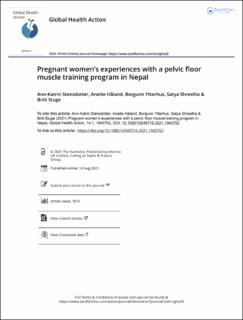| dc.contributor.author | Stensdotter, Ann-Katrin | |
| dc.contributor.author | Håland, Anette | |
| dc.contributor.author | Ytterhus, Borgunn | |
| dc.contributor.author | Shrestha, Satya | |
| dc.contributor.author | Stuge, Britt | |
| dc.date.accessioned | 2022-04-20T12:30:30Z | |
| dc.date.available | 2022-04-20T12:30:30Z | |
| dc.date.created | 2021-10-06T13:03:55Z | |
| dc.date.issued | 2021 | |
| dc.identifier.citation | Global health action. 2021, 14 (1), 1-12. | en_US |
| dc.identifier.issn | 1654-9716 | |
| dc.identifier.uri | https://hdl.handle.net/11250/2991651 | |
| dc.description.abstract | Background
In Nepal, pelvic floor disorders affect about 24% of the women in reproductive age whereof 10% suffer from pelvic organ prolapse (POP). Still, many do not seek health care. Strengthening exercises for the pelvic floor muscles for prevention and treatment of POP has shown strong evidence internationally, but for women in Nepal surgery is primarily offered. To amend this, a novel pelvic floor muscle training (PFMT) program for pregnant women was introduced.
Objective
To learn about how the PFMT-program was received by the participating women, their understanding of the importance of doing the exercises, and the constraints of daily life for performing the program.
Methods
A qualitative study design based on a sub-sample (N = 10) from a strategic sample (N = 235) who participated in the PFMT-program. Ten semi-structured in-depth interviews were interpreted according to a phenomenological analytical tradition.
Results
The 10 women were representative for the women who had participated in the PFMT-program with regard to urban residence, socioeconomic, and educational standing. The program was well received and compliance satisfactory. In line with the PFMT’s learning outcomes, the women described risk factors, showed knowledge about the pelvic floor muscles, and understood the importance of doing the exercises. They had managed to fit the exercises into their busy daily routines. Meeting peers in exercise groups and understanding from family were positive factors for compliance.
Conclusion
The Nepalese women appear interested in self-care and are making an effort to fit the exercises into their busy schedule. Although the communicative validity was satisfactory, the pragmatic validity cannot be generalized to women in rural areas and under less fortunate socioeconomic and educational circumstances. | en_US |
| dc.language.iso | eng | en_US |
| dc.publisher | Taylor & Francis Open Access | en_US |
| dc.rights | Navngivelse 4.0 Internasjonal | * |
| dc.rights.uri | http://creativecommons.org/licenses/by/4.0/deed.no | * |
| dc.title | Pregnant women’s experiences with a pelvic floor muscle training program in Nepal | en_US |
| dc.type | Peer reviewed | en_US |
| dc.type | Journal article | en_US |
| dc.description.version | publishedVersion | en_US |
| dc.source.pagenumber | 1-12 | en_US |
| dc.source.volume | 14 | en_US |
| dc.source.journal | Global health action | en_US |
| dc.source.issue | 1 | en_US |
| dc.identifier.doi | 10.1080/16549716.2021.1940762 | |
| dc.identifier.cristin | 1943773 | |
| cristin.ispublished | true | |
| cristin.fulltext | original | |
| cristin.qualitycode | 1 | |

